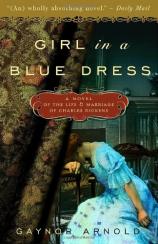Girl in a Blue Dress: A Novel Inspired by the Life and Marriage of Charles Dickens
Review
Girl in a Blue Dress: A Novel Inspired by the Life and Marriage of Charles Dickens
PBS’s popular “Masterpiece Theatre” program
recently produced a multi-part televised adaptation of Charles
Dickens’s LITTLE DORRIT, considered by many to be one of the
author’s most accomplished works. During the introduction to
one of the episodes, the host commented that despite
Dickens’s lifelong marriage, by the time of the writing of
this novel he had fallen out of love with his extremely fertile
(and, as a result, rather stout) wife, preferring instead the
affections of a childlike, domestic, sweet and mild-mannered girl
--- someone very much like the character of Amy Dorrit herself. In
LITTLE DORRIT, the hero, Arthur Clennam, is horrified to discover
that, during his years abroad, his childhood sweetheart has
ballooned into a vast but vacuous woman, a figure to be both pitied
and mocked --- and contrasted with the earnest sweetness and
childlike beauty of Amy Dorrit. What must Dickens’s wife have
felt to see her own sad marriage reduced to fictional farce?
In GIRL IN A BLUE DRESS, author Gaynor Arnold seeks to explore
this question and others, as she writes her book from the point of
view of a woman inspired by Charles Dickens’s wife,
Catherine. The Dickensian character is named Alfred Gibson; his
wife is Dorothea. However, it would soon become clear to those with
even a passing knowledge of Dickens’s career that Gibson is a
stand-in for the most famous Victorian novelist. Catherine Dickens
has been reduced to supporting character status in most books about
her famous husband; here she is given a chance to tell her own
story.
GIRL IN A BLUE DRESS opens the day of Gibson’s funeral;
Dorothea, who has been cast out from the family (including being
estranged from most of her six surviving children), chooses to
remain in the shadows rather than face the twin horrors of the
crowd’s adulation of her husband and her own very public
shame. Dorothea is visited by her eldest daughter, Kitty, who,
although she was her father’s favorite, has still remained
loyal to her mother. As Kitty recounts the mania that has overtaken
London in the wake of her father’s death, Dorothea casts her
mind back to the very earliest days of her courtship by “The
One and Only,” as Gibson becomes known. Gibson is alternately
egotistical and endearingly eccentric, dramatic and dour, as he
entreats Dorothea to be more fun-loving but reminds her that they
both must work very hard to avoid the poverty and misery that
characterized so much of his own youth.
With marriage came conjugal bliss and babies; faced with
Dorothea’s more matronly figure and maternal
responsibilities, Gibson’s attention often strays elsewhere.
The master storyteller, however, is also quite skilled at
fabricating justifications for his own interest in, and behavior
toward, young women --- including Dorothea’s own younger
sisters. As Dorothea retells the sad saga of her marriage to
Gibson, she illustrates the combination of pride and disappointment
that characterize marriage to one so talented, so famous and so
single-minded --- a man whose greatest devotion was not to his
wife, but to the characters he created.
In the days and weeks following Gibson’s death, even as
she considers all this history, Dorothea has a choice to make. Will
she continue to be a virtual prisoner in her own home, bound by
shame and isolated from the friends and family who used to love
her? Or will she use her famous husband’s demise as an
opportunity to rejoin the outside world?
Those with only a passing knowledge of the life and work of
Charles Dickens will still find much to enjoy in this fascinating
character study of a Victorian woman in what seems to be an
impossible situation. Dickensophiles, however, will be delighted
not only by the opportunity to read a fictionalized autobiography
of one of the key figures in Dickens’s own life, but also by
the seamless way in which Arnold skillfully incorporates
Dickens’s characters into his life story. GIRL IN A BLUE
DRESS will show readers a new side of Dickens --- one that portrays
the great author as more flawed, perhaps, but also more human ---
and a portrait of the great man’s wife as a fully realized
character, a product of her times and circumstances, not just as a
literary device or farce.
Reviewed by Norah Piehl on January 22, 2011
Girl in a Blue Dress: A Novel Inspired by the Life and Marriage of Charles Dickens
- Publication Date: August 3, 2010
- Genres: Fiction
- Paperback: 432 pages
- Publisher: Broadway
- ISBN-10: 0307463028
- ISBN-13: 9780307463029




